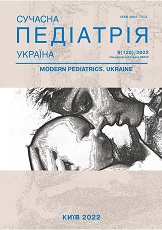Combined course of acute respiratory coronavirus disease in a child with type 1 diabetes: a clinical case
DOI:
https://doi.org/10.15574/SP.2022.126.88Keywords:
children, type 1 diabetes mellitus, respiratory pathology, coronavirus disease, COVID-19Abstract
The clinical course of coronavirus disease (COVID-19) in children in combination with diabetes mellitus is characterized by a more pronounced intensity of clinical manifestations and more frequent complications compared to patients without this premorbid condition. For unknown reasons, the Severe Acute Respiratory Syndrome Coronavirus 2 (SARS-CoV-2) may trigger new-onset diabetes. Over the last decade, the incidence of type 1 diabetes mellitus has increased and the peak age for being diagnosed with type 1 diabetes mellitus is getting younger.
This article presents a clinical case of an adolescent female patient with new-onset type 1 diabetes mellitus diagnosed during hospitalization for symptomatic COVID-19 (SARS-CoV-2 was confirmed by polymerase chain reaction of naso/oropharyngeal swabs). The patient felt ill suddenly, her condition was rapidly worsening. She was hospitalized with severe acute respiratory tract infection. The blood work of the patient revealed hyperglycemia, hyperstenuria, glycosuria, ketonuria, hypertransferasemia, elevated levels of glycated hemoglobin and decreased levels of C-peptide. The patient has been receiving fluid replacement treatment intravenously, short-acting insulin to correct hyperglycemia followed by symptomatic treatment therapy. The patient responded well to the treatment plan and was discharged from the hospital after 8 days continuing treatment from home.
Conclusions. The presented article describes a clinical case of COVID-19 in adolescent female patient with new-onset type 1 diabetes mellitus. The patient’s severe condition was caused mainly by dehydration and COVID-19 precipitated ketoacidosis despite having light respiratory symptoms. At the moment, it is not enough data to conclude whether type 1 diabetes mellitus in pediatric population can cause serious complications from COVID-19. More studies are required to reach a definitive conclusion.
The study was conducted in accordance with the Declaration of Helsinki. Informed consent was obtained from the patient’s parents before the study.
No conflict of interests was declared by the authors.
References
Alaqeel A, Aljuraibah F, Alsuhaibani M, Huneif M et al. (2021, Apr). The Impact of COVID-19 Pandemic Lockdown on the Incidence of New-Onset Type 1 Diabetes and Ketoacidosis Among Saudi Children. Frontiers in Endocrinology. 12: 1-5. https://doi.org/10.3389/fendo.2021.669302; PMid:33868185 PMCid:PMC8049603
DiMeglio LA, Albanese-O'Neill A, Muñoz CE, Maahs DM. (2020). COVID-19 and children with diabetes-updates, unknowns, and next steps: first, do No extrapolation. Diabetes Care. 43 (11): 2631-2634. https://doi.org/10.2337/dci20-0044; PMid:32887703
Huang C, Wang Y, Li X et al. (2020). Clinical features of patients infected with 2019 novel coronavirus in Wuhan, China. Lancet (London, England). 395 (10223): 497-506. https://doi.org/10.1016/S0140-6736(20)30183-5; PMid:31986264
Kamrath C, Mönkemöller K, Biester T et al. (2020). Ketoacidosis in Children and Adolescents With Newly Diagnosed Type 1 Diabetes During the COVID-19 Pandemic in Germany. JAMA. 324 (8): 801-804. https://doi.org/10.1001/jama.2020.13445; PMid:32702751 PMCid:PMC7372511
Koliaki C, Tentolouris A, Eleftheriadou I, Melidonis A, Dimitriadis G, Tentolouris N. (2020). Clinical management of diabetes mellitus in the era of COVID-19: practical issues, peculiarities and concerns. J Clin Med. 9 (7): 1-25. https://doi.org/10.3390/jcm9072288; PMid:32708504 PMCid:PMC7408673
Misra A, Ghosh A, Gupta R. (2021). Heterogeneity in presentation of hyperglycaemia during COVID-19 pandemic: A proposed classification. Diabetes & Metabolic Syndrome: Clinical Research & Reviews. 15 (1): 403-406. https://doi.org/10.1016/j.dsx.2021.01.018; PMid:33588198 PMCid:PMC7847699
Nassar M, Nso N, Baraka B, Alfishawy M, Mohamed M, Nyabera A, Sachmechi I. (2021). The association between COVID-19 and type 1 diabetes mellitus: A systematic review. Diabetes & Metabolic Syndrome: Clinical Research & Reviews. 15 (1): 447-454. https://doi.org/10.1016/j.dsx.2021.02.009; PMid:33592371 PMCid:PMC7872855
Nielsen-Saines K, Li E, Olivera AM, Martin-Blais R, Bulut Y. (2021). Case Report: Insulin-Dependent Diabetes Mellitus and Diabetic Keto-Acidosis in a Child With COVID-19. Frontiers in Pediatrics. 9: 1-5. https://doi.org/10.3389/fped.2021.628810; PMid:33643977 PMCid:PMC7902688
Okhotnikova OM, Ivanova TP, Oshlyanskaya OA, Ponochevnaya OV et al. (2020). Treatment protocol of coronavirus infection (COVID-19) in children with chronic somatic diseases. Modern Pediatrics. Ukraine. 4(108): 18-32. https://doi.org/10.15574/SP.2020.108.18
Soliman AT, Al-Amri M, Alleethy K, Alaaraj N, Hamed N, De Sanctis V. (2020). Newly-onset type 1 diabetes mellitus precipitated by COVID-19 in an 8-month-old infant. Acta biomedical. 91 (3): e2020046. https://doi.org/10.23750/abm.v91i3.10074.
Woodruff C, Campbell AP, Taylor ChA et al. (2022). Risk Factors for Severe COVID-19 in Children. Pediatrics. 149 (1): e2021053418. https://doi.org/10.1542/peds.2021-053418; PMid:34935038
Downloads
Published
Issue
Section
License
Copyright (c) 2022 Modern pediatrics. Ukraine

This work is licensed under a Creative Commons Attribution-NonCommercial 4.0 International License.
The policy of the Journal “MODERN PEDIATRICS. UKRAINE” is compatible with the vast majority of funders' of open access and self-archiving policies. The journal provides immediate open access route being convinced that everyone – not only scientists - can benefit from research results, and publishes articles exclusively under open access distribution, with a Creative Commons Attribution-Noncommercial 4.0 international license (СС BY-NC).
Authors transfer the copyright to the Journal “MODERN PEDIATRICS. UKRAINE” when the manuscript is accepted for publication. Authors declare that this manuscript has not been published nor is under simultaneous consideration for publication elsewhere. After publication, the articles become freely available on-line to the public.
Readers have the right to use, distribute, and reproduce articles in any medium, provided the articles and the journal are properly cited.
The use of published materials for commercial purposes is strongly prohibited.

